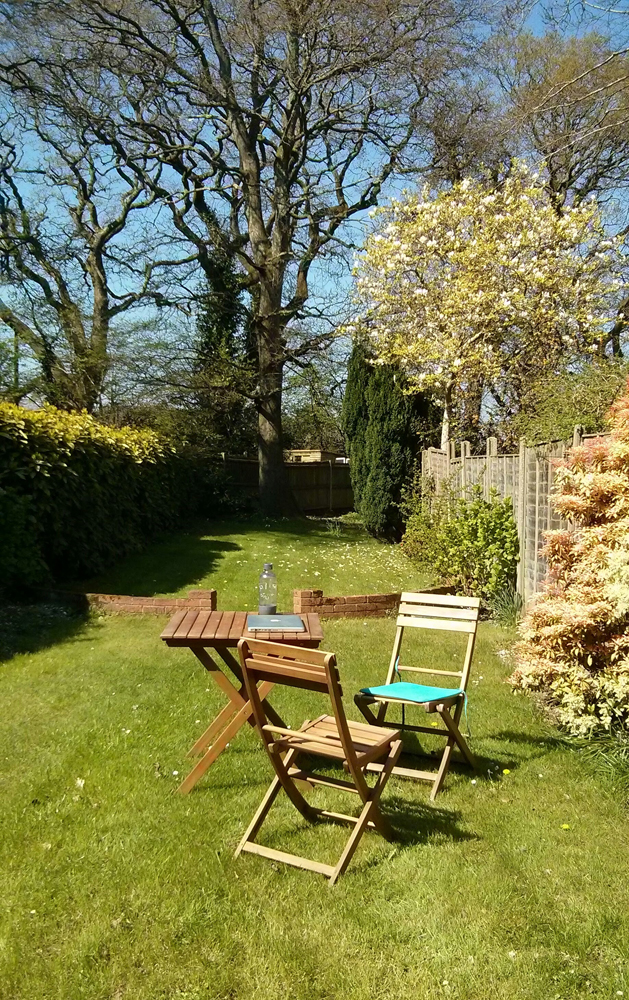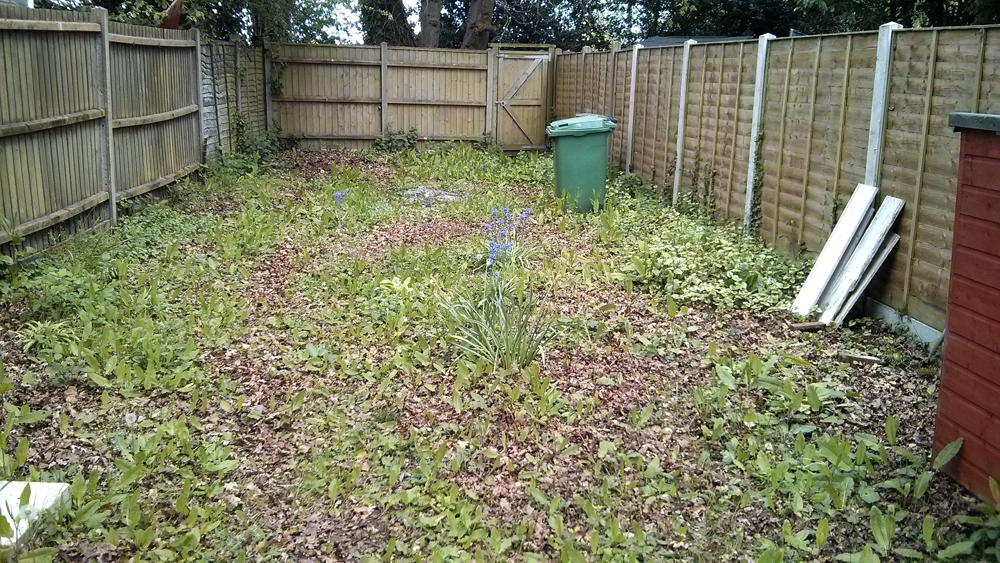What tools does a new gardener need?
So my fiancé and I bought our first house a few months ago and it comes with a narrow but very long garden. Now the first bit of the garden is in decent shape (though will need new fencing and I want to completely redesign it at some point). This photo shows the front bit.

However from where the tree is in the background, the garden needs quite a bit of work. Basically the garden makes a bit of a curve at the end, so this part is mostly obscured from our view when we're in the house, and I assume that is why the previous owners didn't really do much with it (other than use it to burn things).
It's a very shady area as it's right underneath an oak tree, with other trees around in the other gardens (conservation area). So now that part of the garden is covered with dead leaves, lots of weeds and overgrown nettles, ivy, some bramble etc. And lots of random rocks and bricks for some reason.

As this is the first garden I have owned myself, I am not sure where to get started with this! I don't own any tools yet apart from a lawn mower, so I am wondering what I need to invest in right now?
And how do I start clearing this area? Do I just pull all the plants/weeds by hand or is there a tool I can use? How do I dispose of them? I haven't signed up yet to use the green bin, as I was thinking of investing in a composting bin (the Green Johanna one, so I can also compost food), but I am not sure if the weeds can go in there?
Sorry for all the questions, I am completely new at this! Any tips are greatly appreciated, as I want to give this garden some love, but I want to do it right! ![]()
Posts
Basic tools include a fork, a spade and a hoe (Dutch variety). Hand tools that are useful include a hand fork and trowel and, something a few of us on here have recently invested in, a manual tiller. You can google these to find your best buys as Garden Centres can be a bit expensive. Half moon edgers and edge clippers are also useful as is a hedge cutter. Go for stainless steel tools if you can afford them as they are excellent (but not essential) - easy to clean and non rusty.
A gentle word of advice - do not compost food as this will only encouraged rats.
Hi Nini
If it were me faced with that, I'd use a systemic weedkiller.
Systemic weedkillers are sprayed onto the plant and the chemicals enter the plant system and kill it - whether it's a weed or a valued plant - so be careful. Once the stuff hits the soil it becomes inactive and is broken down and leaves no toxic residue, so the ground can be planted again straight away once the weeds are all clearly dead.
It's glyphosphate you're after - readily available as Roundup, or my preference Rosate36 (which is much, much stronger but still the same stuff - glyphosphate).
Use a sprayer (get a 5Litre sprayer) on a calm day and set your sprayer so you get tiny droplets and NOT a mist as it will blow around and kill other stuff.
It'll take 2-3 weeks before you see the weeds dying, and you may need to spray again a couple of weeks later just to kill off any that are still growing.
If you chooses not to use chemicals, then you'll have to dig up the perennial weeds and pull up the annuals. A lot of work!
Billericay - Essex
Knowledge is knowing that a tomato is a fruit.
Wisdom is not putting it in a fruit salad.
I'd echo what LB has said, apart from the compost bit as I don't do that. The other thing you will need is a good strong back but unfortunately you can't buy one of those
The only thing I would add is be careful how you handle those weeds. Don't be tempted to rotavate the area unless you have an idea what weeds are growing as you could make things worse if you have any real nasties. I'd probably weed by hand and and then identify which weeds come back. You could then check how best to treat them.
Good luck with the garden
Crossed in the post Pete8. As you can see NiniS more than one way to skin a rabbit as they say.
I see docks, brambles, nettles, and the dreaded Spanish bluebell. All these things have roots that remain in the soil from which they will regrow. So I agree with Pete, I would glyphosate the lot in that section (allow for a repeat treatment of anything that survives round one) and be sure of a blank slate. From then on, you can create a lovely woodland garden for wildlife that won't require constant battling with weeds.
Welcome to the forum NiniS - and also to the wonderful world of gardening That is a very nice space you have there - lots of possibilities!
That is a very nice space you have there - lots of possibilities!
To answer your first question about a basic 'essentials' tool kit - the items I find indispensable are: a pair of good secateurs, a border (digging) fork, a border spade and a hand (ie small hand weeding) fork.
My general advice when buying those tools which will be in constant use - is to buy the best you can afford. I would recommend going to a large garden centre which stocks a wide range of tools. There you will be able to hold the different tools and see how they feel. I'm very short - so spades and forks designed to be used by strong 6' blokes are usually no use to me. You may also find that different handle styles feel naturally more comfortable to you. Small hand tools should feel comfortable and nicely balanced in the hand.
Once you have your basic kit you will soon find you need things such as loppers and rakes etc etc but the 4 I've listed above are an essential start.
I'd also add a pair of thick gloves if you're going to be handling brambles etc.
Regarding tackling the weeds - I think it depends on what you think you might do with this area.
If you think it will be a general utility area or you might put in hard landscaping or a pond - then zapping the weeds with glyphosate might be the easiest option - although it doesn't work particularly well on ivy and brambles - you'll probably need to dig those out.
If you think you might plant it up (perhaps a woodland themed area?) you might want to dig it over so you can check there are no little treasures already growing there which will be useful in the new planting. If you're sure there isn't - you can still use weedkiller per Pete's instructions.
A Green Johanna will take some weeds but it's not big enough to take all the stuff you will dig out of there - and some of it is not great for composting either. You can buy builders dumpy bags very cheaply online. You can collect the weeds in those and take them by car to your nearest green waste recycling point. They are reusable.
LB is right that the general rule with a normal compost bin is not to put cooked food / meat / dairy in it as it will attract rats. Green Johanna's are supposed to be designed to be rat proof and used for food composting. I don't know anybody who has one so I'm not sure how rat proof they actually are.
You could certainly screen off a bit in your 'problem' area and have a bay of 3 'normal' compost bins made from wooden pallets. Very cheap and very effective.
Agreed with those that mentioned using Glyphosate weedkiller. Think of it as a tool that will save you endless hours of digging.
The garden is seriously infested with Dock Leaves and they aren't easy to kill off with many DIY store weedkillers due to the large taproots. Unfortunately, Dock seeds have a viability for up to a century, so expect many more to crop up in the future. Once the big ones are out of the way, future seedlings are relatively easy to control.
The Ivy may look nice but it WILL destroy your fence over time either breaking the lats or by retaining moisture, causing the panels to rot. Dig the Spanish bluebells up as they are incredibly hard to kill with weedkiller.
As for marerial tools, a good-quality garden fork and spade, hand fork and trowel and a hoe. I use Wolf Garten hoe attachments as they are superb-quality, strong and have a long guarantee. You only need one pole (the wood ones are the strongest) and the attachments can be stored in a small container. No need for rows of hoes, cultivators, rakes, brushes etc lined up in your shed.
Thank you so much for the replies everyone! I really appreciate it!
I think I will look into getting a weedkiller, as it is quite a big area to tackle and I kind of want to start with a clean slate. Though I imagine I will still have to do quite a bit of digging etc to get that area sorted. Thanks as well for labeling some of those weeds, I had no clue what they were other than the easy to identify nettles, bramble and ivy haha.
Also, thank you MowTastic for mentioning Wolf Garten. I had never heard of them before, but being able to switch attachments sounds great! Will save quite a bit of space, which is useful as we don't have a shed yet.
I'll be sure to come back on here if I have any issues or questions... which I am sure I will have as a newbie gardener!
When choosing your spades and forks consider their size compared to your own! What are generally referred to a garden spades are larger than border spades, likewise the forks. It may seem like a good idea to get the bigger option, but they can get tiring very quickly particularly on heavy soil.
I always used a 'full size' ie garden spade up to a few years ago, I then changed to a border spade and found I could work for longer with that, and suffer fewer back problems.
If you don't need the top area for a while you could cover it with thick black polythene sheet. Leave it on as long as possible, up to a year if you can. This will kill off a lot of weeds or at least weaken them a lot making them easier to deal with. I agree with the tool suggestions, the wolf system is not cheap but very convenient, you can buy attachments gradually as you need them. Personally I think stainless steel is only good for trowels & some other small tools, the trouble with it as a material is; it is expensive, brittle, difficult to sharpen (because it is so hard). Good quality steel tools can be kept sharp, which it vital for best performance. This to me outweighs the benefit of stainless which is it stays cleaner as wet soil does not stick so easily. It is personal preference!